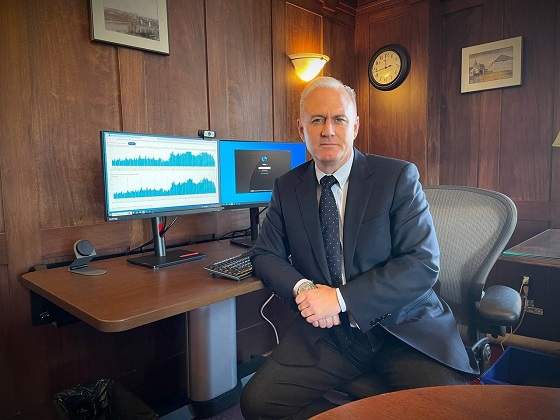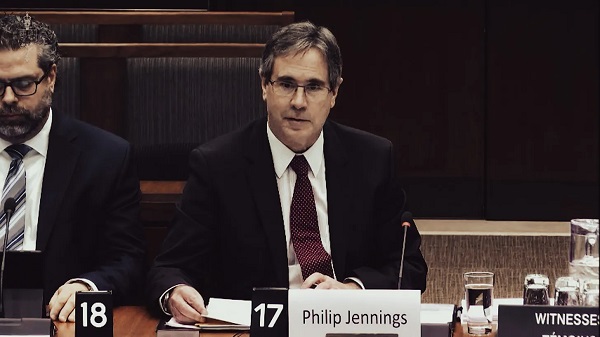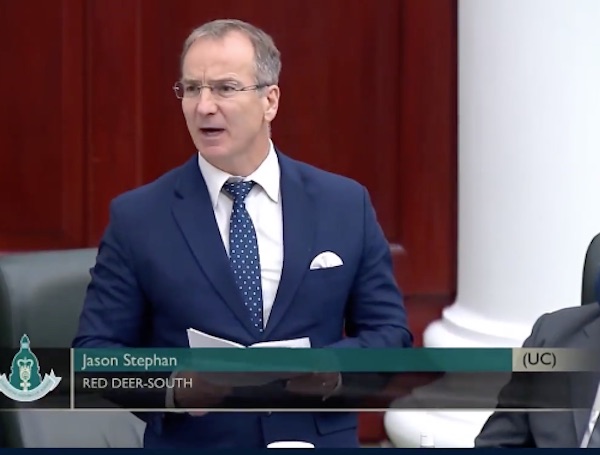Addictions
A conversation with Premier Smith’s outgoing chief of staff, architect of Alberta’s recovery-focused drug policies

Marshall Smith, Alberta’s Chief of Staff, sits in his office at the Alberta Legislature in Edmonton
Marshall Smith, on what he has learned as an addict and policy leader and what’s next for him
Alberta Premier Danielle Smith’s chief of staff, Marshall Smith, is leaving his post at the end of October.
Since taking office in 2022, he has been instrumental in shaping Alberta’s drug policies and developing the Alberta Model — a recovery-focused addiction treatment policy that has gained international recognition for enhancing access to mental health and addiction services.
Under his guidance, Alberta has prioritized building recovery communities over harm-reduction programs. Government data show a 53 per cent decrease in opioid-related overdose deaths in June 2024 from the prior year, which may suggest Smith’s initiatives are having an impact.
In a statement on social media, the Premier shared that Smith informed her of his decision to retire earlier this year, after dedicating 32 years to public service. His departure comes just ahead of the United Conservative Party’s leadership review on Nov. 2.
Smith met with reporter Alexandra Keeler on Sept. 10 to discuss his personal journey from addiction to recovery and how it has shaped Alberta’s drug policies. On Oct. 10, they spoke by phone to discuss his recent decision to step down and what lies ahead for him.
AK: What emotional and psychological impact did your addiction have on your sense of self?
MS: It makes you feel powerless. Addiction is an illness of isolation, despair, loneliness and powerlessness. One of the hallmarks of addiction is continuing to use a substance despite a complete lack of control over your using, and over the circumstances that you’re in.
AK: Do you think that sense of powerlessness impacts an individual’s ability to provide informed consent for involuntary treatment?
MS: I think that, over time, if addiction is left unchecked or untreated, or is allowed to progress to its very latter stages, you absolutely lose agency over your ability to make decisions.
I used to get the question a lot: ‘Is it a disease? Is it a choice?’ And I say it’s both. It’s actually a disease of choices, which is to say that it’s a disease or an illness that affects my brain’s ability to make good choices.
AK: Were you the driving force behind Alberta’s shift away from harm reduction towards a recovery-focused approach, or was there a broader change in attitudes within the community?
MS: Certainly I’m not solely responsible. I’m a member of a broad community of people in recovery who have been advocating for these policies for two decades. I think that I have a background [and] certain skills that have found me in positions like this, where I can be most effective helping my community advance these ideas and concepts and actually get them implemented into policy and action.
AK: Obviously your lived experience with addiction brings a valuable perspective to the table. But what data sources are the province using to inform its addiction and recovery policies?
MS: We have a very broad literature base that we use to inform a lot of our policy decisions … Alberta [also] has the most comprehensive data collection and data analytics system in North America, bar none.
A practical example of how that’s useful is … [if] the data shows us that a very high number of people who were in custody — whether that’s corrections or police custody — went on to fatally overdose in a period after their release, that tells us that we need to focus on correctional programs, and we need to focus on policing programs.
And we’ve done that. We have amazing new correctional treatment programs that are second to none. I don’t know of anybody in Canada that’s doing this — we’ve taken [jail units where inmates sleep and live] and turned them into treatment centres, and connected them with our new treatment centres outside of jails. We partnered with police, because police have probably the most amount of contact with people who are using substances, and we gave them the ability to help people get on to opioid-substitution medications.
We’re going to go even further. Minister [of Mental Health and Addiction Dan] Williams has just announced the creation of the Centre of Recovery Excellence (CoRE), which is a first of its kind in Canada. It’s a Crown corporation not beholden to pharmaceutical money, which is a big change for us, and we were very deliberate about that.
[CoRE] will give us the ability to pull in data from across systems in government and have that data analyzed … So we’re entering into a very exciting time in terms of data and analytics around this issue.
AK: Without CoRE fully operational yet, what made you confident the recovery-focused approach would succeed?
MS: I see hundreds of thousands of Canadians every day entering recovery and maintaining their recovery … What I see in the alternative is a lot of drug use, homelessness, despair, disease [and] crime.
We spend a lot of time talking about data and evidence and science, and all of those things are good and necessary … but it’s not the only component of the decision-making process. … The policies that we’re making and the pathways that we take also have to be informed by the values of the community that we serve. … For far too long in Canada, that hasn’t been a consideration.
I think that we are at a place in Canada where the country is saying to us it’s time to revisit the direction that we’ve been going. I think that they’re saying to us, as policymakers, that we gave this a chance. We had become convinced by experts and the media … to give [pro-drug, harm-reduction policies like safer supply] a try …
[A]fter 20 years of that, I think that Canadians are ready to throw in the towel and to say, ‘We’re done with this. We’ve given you enough time to prove out your thesis. It’s not worked, and now we’re looking for fresh ideas.’
So Alberta is here leading that conversation of fresh and different ideas, and we’re happy to have that role.
The remainder of this interview took place on Oct. 10.
AK: Premier Smith announced your retirement at the end of October. What prompted your decision to step down?
MS: My time in Alberta has been a lengthy and intense role of system transformation over two premiers and standing up government twice.
While there’s still a lot of work to be done here, we have a tremendous team in Alberta that is leading that work under Minister Williams. I just felt that it’s time for me to step out of the role and continue to serve in other capacities.
AK: Looking ahead, what aspects of the Alberta Model will you carry with you into your future endeavours?
MS: I would say all aspects of the model need to be expanded across Canada, for jurisdictions that are interested.
Where I can be of the most assistance to other governments is talking to them about how to effectively organize themselves to be successful in this area. I think that governments across the country are struggling to figure out how to do that.
AK: What new opportunities do you hope to pursue that you haven’t been able to explore during your time in this role? Will your focus continue to be in addiction and drug policy?
MS: The majority of my focus will be on addiction and drug policy, but I have other areas of interest.
I’m passionate about the work that we’re doing with Indigenous people … I’m also very passionate about emerging technology and how we’re going to use that to uncover some of the answers that we’re looking for on these models.
I’m looking forward to having a little bit more freedom and focus.
This interview has been edited and condensed for clarity.
This article was produced through the Breaking Needles Fellowship Program, which provided a grant to Canadian Affairs, a digital media outlet, to fund journalism exploring addiction and crime in Canada. Articles produced through the Fellowship are co-published by Break The Needle and Canadian Affairs.
Subscribe to Break The Needle. Our content is always free – but if you want to help us commission more high-quality journalism, consider getting a voluntary paid subscription.
Addictions
Manitoba Is Doubling Down On A Failed Drug Policy

From the Frontier Centre for Public Policy
Manitoba is choosing to expand the same drug policy model that other provinces are abandoning, policies that normalize addiction while sidelining treatment, recovery, and public safety.
The New Democrat premier of British Columbia, David Eby, stood before reporters last spring and called his government’s decision to permit public drug use in certain spaces a failure.
The policy was part of the broader “harm reduction” strategy meant to address overdose deaths. Instead, it had stirred public anger, increased street disorder and had helped neither users nor the communities that host them. “We do not accept street disorder that makes communities feel unsafe,” Eby said. The province scrapped the plan.
In Alberta, the Conservative government began shutting down safer-supply prescribing due to concerns about drug diversion and misuse. The belief that more opioids can resolve the opioid crisis is losing credibility.
Ontario Progressive Conservatives are moving away from harm reduction by shutting down supervised consumption sites near schools and limiting safer-supply prescribing. Federal funding for programs is decreasing, and the province is shifting its focus to treatment models, even though not all sites are yet closed.
Yet amid these non-partisan reversals, Manitoba’s government has announced its intention to open a supervised drug-use site in Winnipeg. Premier Wab Kinew said, “We have too many Manitobans dying from overdose.” True. But it does not follow that repeating failed approaches will yield different results.
Reversing these failed policies is not a rejection of compassion. It is a recognition that good intentions do not produce good outcomes. Vancouver and Toronto have hosted supervised drug-use sites for years. The death toll keeps rising. Drug deaths in British Columbia topped 2,500 in 2023, even with the most expansive harm reduction infrastructure in the country. A peer-reviewed study published this year found that hospitalizations from opioid poisoning rose after B.C.’s safer-supply policy was implemented. Emergency department visits increased by more than three cases per 100,000 population, with no corresponding drop in fatal overdoses.
And the problem persists day to day. Paramedics in B.C. responded to nearly 4,000 overdose calls in July 2024 alone. The monthly call volume has exceeded 3,000 almost every month this year. These are signs of crisis management without a path to recovery.
There are consequences beyond public health. These policies change the character of neighbourhoods. Businesses suffer. Residents feel unsafe. And most tragically, the person using drugs is offered little more than a cot, a nurse and a quiet signal to continue. Real help, like treatment, housing and purpose, remains out of reach.
Somewhere along the way, bureaucracies stopped asking what recovery looks like. They have settled for managing human decline. They call it compassion. But it is really surrender, wrapped in medical language.
Harm reduction had its time. It made sense when it first emerged, during the AIDS crisis, when dirty needles spread HIV. Back then, the goal was to stop a deadly virus. Today, that purpose has been lost.
When policy drifts into ideology, reality becomes an afterthought. Underneath today’s approach is the belief that drug use is inevitable, that people cannot change, that liberty means letting others fade away quietly. These ideas do not reflect science. They do not reflect hope. They reflect despair. They reflect a politics that prioritizes the appearance of compassion over effectiveness.
What Manitoba needs is treatment access that meets the scale of the problem. That means detox beds, recovery homes and long-term care focused on restoring lives. These may not generate the desired headlines, but they work. They are demanding. They are slow. And they offer respect to the person behind the addiction.
There are no shortcuts. No policy will undo decades of pain overnight. But a policy that keeps people stuck using is not mercy. It is maintenance with no way out.
A government that believes in its people should not copy failure.
Marco Navarro-Genie is vice-president of research at the Frontier Centre for Public Policy and co-author, with Barry Cooper, of Canada’s COVID: The Story of a Pandemic Moral Panic (2023).
Addictions
The Death We Manage, the Life We Forget

 Marco Navarro-Génie
Marco Navarro-Génie
Our culture has lost the plot about what it means to live.
Reading that Manitoba is bringing supervised consumption to Winnipeg got me thinking.
Walk through just about any major Canadian city, and you will see them. Figures bent forward at seemingly impossible angles, swaying in the characteristic “fentanyl fold,” suspended between consciousness and oblivion. They resemble the zombies of fiction: bodies that move through space without agency, awareness, or connection to the world around them. We think of zombies as the walking dead. Health workers and bureaucrats reverse their overdoses, send them back to the street, and call it saving lives.
At the same time, Canada offers medical assistance in dying to a woman who cited chemical sensitivities and the inability to find housing. It has been offered to veterans who asked for support and were met instead with an option for death. We fight to prevent one form of death while facilitating another. The contradiction is not accidental. It reveals something about the people involved and the funding behind it. That’s our culture. Us. It appears to me that our culture no longer knows what life is.
Ask any politician or program bureaucrat, and you will hear them explain, in the dry language of bureaucracy, that the twin approach to what they call harm reduction and medical assistance in dying (MAiD) rests on the shared premise of what they believe to be compassion. They think they respect autonomy, prevent suffering, and keep people alive when possible. It sounds humane. It is, in practice, incoherent. Bear with me for a moment.
The medical establishment administers naloxone to reverse overdoses in people who spend as many as twenty hours a day unconscious. They live without meaningful relationships or memories, with little capacity for choice. The technocrats and politicians call that saving lives. They also provide assisted death to people whose suffering comes primarily from poverty, isolation, or lack of housing. There was a time when these factors could, at least in theory, be addressed so that the terminal decision did not need to be made. Now they are accepted as grounds for ending life.
But why is one preference final and the other treated as an error to correct? That question reflects the deeper disorientation.
We saw the same thing during COVID. Elderly people in care homes were left without touch, family, or comfort for days. They often died in solitude, their dementia accelerated by isolation. And those conditions were inflicted upon them in the name of saving their lives. The “system” measured success in preventing infections, not in preserving connections. Je me souviens. Or we should.
There is a pattern here. We have reduced the idea of saving lives to keeping bodies breathing, while ignoring what makes a life human: agency, meaning, development, and relationship. And in doing so, we begin to define life as mere biological persistence. But to define life by the capacity to breathe and perform basic functions is to place ourselves on the same footing as the non-human animals. It is to say, tacitly, that there is no fundamental distinction between a person and a creature. That, too, is a form of forgetting.
To be clear, the argument here is not that hopeless drug users should be administered MAiD. Instead, it is essential to recognize that the intellectual framework behind harm reduction and MAiD must be taken seriously, as it rests on some rationally defensible claims. In an age where most arguments are emotive and unexamined, the mildly logical has become strangely compelling.
It begins with the idea of autonomy. We cannot force others to live by our values. Every person must decide what makes life worth living. To insist otherwise is paternalism.
Then comes pragmatic compassion. People will use drugs whether we approve or not. People will find their lives unbearable, whether we acknowledge it or not. We can support them or moralize while they die.
There is also an emphasis on subjective experience. No one knows another’s pain. If someone says their suffering is intolerable, we are in no position to deny it, they say. If a user would rather face opioids than withdrawal and despair, are we entitled to interfere?
Finally, the comparison to medical ethics: we do not withhold insulin from diabetics who continue to eat poorly. We do not deny cancer treatment to smokers. Medicine responds to suffering, even when the patient has contributed to their condition. Harm reduction, they argue, simply applies that principle to addiction.
These arguments produced tangible benefits, they argue. Needle exchanges reduced HIV transmission. Naloxone kits prevented deaths. Safe injection sites meant fewer people dying alone. MAiD brought relief to those in agony. These were not trivial outcomes. I am aware.
Yet when we look more closely, the very logic that underlies these policies also exposes their fatal limitations.
Addiction undermines choice. It hijacks the brain’s ability to reason, compare, and choose. A person deep in addiction is not selecting between alternatives like someone choosing coffee or tea. The structure of choice, the human will, itself is broken. The addiction decides before the person does. St Augustine knew this. Dostoyevsky knew it too.
And for the empirically minded, the research supports this. In British Columbia, where the “safe supply” model was pioneered, some addiction physicians now say the policy is failing. Worse, it may be creating new opioid dependencies in people who were not previously addicted. A study earlier this year found that opioid‑related hospitalizations increased by about 33 percent, compared with pre‑policy rates. With the later addition of a drug-possession decriminalization policy, hospitalizations rose even more (overall, a 58 percent increase compared to before SOS’s implementation). The study concluded that neither safer supply nor decriminalization was associated with a statistically significant reduction in overdose deaths. This is not freedom. It is a new form of bondage, meticulously paved by official compassion.
Despair disguises itself as autonomy, especially in a spiritually unmoored culture that no longer knows how to cope with suffering. A person requesting assisted death because of chronic, untreatable pain may appear lucid and composed, but lucidity is not the same as wisdom. One can reason clearly from false premises. If life is reduced to the absence of pain and the preservation of comfort, then the presence of suffering will seem like failure, and death will appear rational. But that is not a genuine choice because it is based on a misapprehension of what life is. All life entails pain. Some of it is redemptive. Some of it is endured. But it does not follow that the presence of suffering justifies the conclusion of life.
Someone turning to drugs because of homelessness, abandonment, or despair is often in an even deeper eclipse of the will. Here, there is not even the appearance of deliberation, only the reach for numbness in the absence of meaning. What looks like a decision is the residue of collapse. We are not witnessing two forms of autonomy, one clearer than the other. We are witnessing the breakdown of autonomy in various forms, and pretending that it is freedom.
Biological survival is not life. When we maintain someone in a state of near-constant unconsciousness, with no relationships, no capacity for flourishing, we are not preserving life. We are preserving a body. The person may already be gone. To define life as nothing more than breathing and performing bodily functions is to deny what makes us human. It reduces us to the level of non-human creatures, sentient, perhaps, but without reason, memory, moral reflection, or the possibility of transcendence. It tacitly advances the view that there is no essential difference between a person and a critter, so long as both breathe and respond to some stimuli.
Governments do these things to keep ballooning overdosing deaths down, preferring to maintain drugs users among the undead instead. That reminds me of how the Mexican government hardly moves a finger to find the disappeared, 100,000 strong of lately. For as long ss they’re disappeared, they choose not to count them as homicides, and they feel justified in ignoring the causes of all the killing around them.
Some choices are nefarious. Some choices deserve challenge. Not all autonomous acts are equal. The decision to continue living with pain, or to fight addiction, requires agency. The decision to surrender to despair may signal the absence of it. To say all choices are equal is to empty the word autonomy of meaning.
This reflects a dangerously thin view of the human person that permeates our present. What we now call “harm” is only death or physical pain. What we call good is whatever someone prefers. But people are more than collections of wants.
We should have learned this by now. In Alberta, safer supply prescribing was effectively banned in 2022. Officials cited diversion and lack of measurable improvement. We are forcing some people into treatment because we recognize the impairment of judgement in addiction.
In British Columbia, public drug use was quietly re-criminalized after communities rebelled. This was an admission of policy failure. “Keeping people safe is our highest priority,” Premier David Eby said. Yet safe supply remains. In 2023, the province recorded more than 2,500 overdose deaths. Paramedics continue to respond to thousands of overdose calls each month. This is not success. It is a managed collapse.
Meanwhile, Manitoba is preparing to open its own supervised drug-use site. Premier Wab Kinew said, “We have too many Manitobans dying from overdose… so this is one tool we can use.” That may be so. However, it is a tool that others are beginning to set aside. It is a largely discredited tool. Sadly, in the self-professed age of “Reconciliation” with Aboriginal Canadians, Aboricompassionadians are disproportionately affected by these discredited policies.
The Manitoba example illustrates the broader problem, despite damning evidence. Instead of asking what helps people live, we ask whether they gave consent. We do not ask whether they were capable of it. We ask whether they avoided death. We do not ask whether they found purpose.
We are not asking what might lead someone out of addiction. We are not asking what they need to flourish. We ask only what we can do to prevent them from dying in the short term. And when that becomes impossible, technocracy offers them death in a more organized form, cleanly approved by government. That’s compasson.
The deeper problem is not policy incoherence. It is the cultural despair that skates on the thin ice of meaninglessness. These policies make sense only in a culture that has already decided life is not worth too much. What matters is state endorsement and how it’s done .
It is more cost-effective to distribute naloxone than to construct long-term recovery homes. It is easier to train nurses to supervise injection than to provide months of residential treatment. It is far simpler to legalize euthanasia for the poor and the suffering than to work on solutions that lift them out of both. But is it right?
This is not compassion. It is surrender.
A humane policy would aim to restore agency, not validate its absence. It would seek out what helps people grow in wisdom and self-command, not what leaves them comfortably sedated. It would measure success not in lives prolonged into darker dependency but in persons recovered. In lives better lived.
This vision is harder. It costs time. It requires greater effort. It requires care and what some Christians call love of neighbour. It may require saying no when someone asks for help that could lead to ruin. But anything less is not mercy. It is a slow walk toward death while we leave the “system” to pretend there is no choice.
We did have a choice. We chose shallow comfort over deep obligation. We chose to manage symptoms rather than confront the deeper conditions of our age: loneliness, meaninglessness, despair. And now we live among the results: more, not fewer, people swaying in silence, already gone walking dead.
We might ask what we’ve forgotten about suffering, about responsibility, about what life is. Lives are at stake. True. But when our understanding of life is misdirected, so will be the policies the state gives us.
We are grateful that you’re reading Haultain Research.
For the full experience, and to help us bring you more quality research and commentary,
-

 Business2 days ago
Business2 days agoRecent price declines don’t solve Toronto’s housing affordability crisis
-

 Daily Caller2 days ago
Daily Caller2 days agoTech Mogul Gives $6 Billion To 25 Million Kids To Boost Trump Investment Accounts
-

 Alberta1 day ago
Alberta1 day agoAlberta will defend law-abiding gun owners who defend themselves
-

 Business2 days ago
Business2 days agoCanada’s future prosperity runs through the northwest coast
-

 Alberta1 day ago
Alberta1 day agoThis new Canada–Alberta pipeline agreement will cost you more than you think
-

 Business2 days ago
Business2 days agoOttawa’s gun ‘buyback’ program will cost billions—and for no good reason
-

 National2 days ago
National2 days agoCanada Needs an Alternative to Carney’s One Man Show
-

 MAiD16 hours ago
MAiD16 hours agoFrom Exception to Routine. Why Canada’s State-Assisted Suicide Regime Demands a Human-Rights Review








